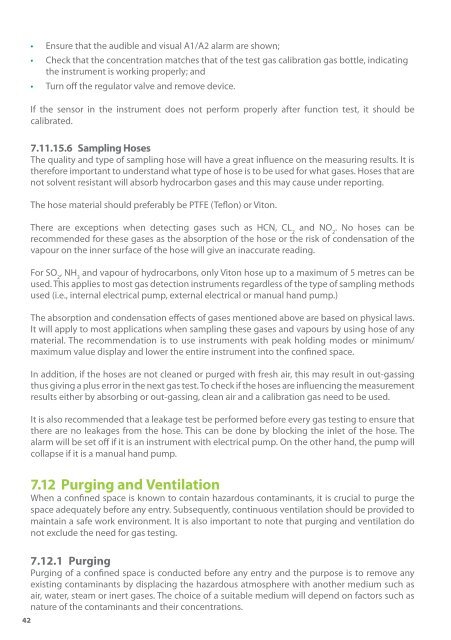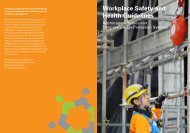Confined Spaces - Workplace Safety and Health Council
Confined Spaces - Workplace Safety and Health Council
Confined Spaces - Workplace Safety and Health Council
- No tags were found...
You also want an ePaper? Increase the reach of your titles
YUMPU automatically turns print PDFs into web optimized ePapers that Google loves.
• Ensure that the audible <strong>and</strong> visual A1/A2 alarm are shown;• Check that the concentration matches that of the test gas calibration gas bottle, indicatingthe instrument is working properly; <strong>and</strong>• Turn off the regulator valve <strong>and</strong> remove device.If the sensor in the instrument does not perform properly after function test, it should becalibrated.7.11.15.6 Sampling HosesThe quality <strong>and</strong> type of sampling hose will have a great influence on the measuring results. It istherefore important to underst<strong>and</strong> what type of hose is to be used for what gases. Hoses that arenot solvent resistant will absorb hydrocarbon gases <strong>and</strong> this may cause under reporting.The hose material should preferably be PTFE (Teflon) or Viton.There are exceptions when detecting gases such as HCN, CL 2<strong>and</strong> NO 2. No hoses can berecommended for these gases as the absorption of the hose or the risk of condensation of thevapour on the inner surface of the hose will give an inaccurate reading.InertingInerting is a form of purging which involves removing oxygen from the confined spaceby displacing it with inert gases such as nitrogen (N 2) <strong>and</strong> carbon dioxide (CO 2). Inerting iscommonly used to remove the potential hazards of fire <strong>and</strong> explosion by reducing oxygento a concentration that is below the level that can support combustion. When inerting,care must be taken to ensure that following the purging of the contaminants with inertgases, the space must be ventilated with fresh air to restore the atmosphere to normalatmospheric condition. Also, when purging flammable substances, the equipment usedsuch as nozzles <strong>and</strong> pipes must be bonded to the space to prevent the build up of staticcharges which can cause ignition.7.12.1.1 Purge TimeThe amount of time that is required to remove the contaminants is dependent on theconcentration of the contaminants <strong>and</strong> the capacity of the air moving devices used. If no furthercontaminant release is expected (static condition), the following formula* can be used tocalculate the amount of time needed.For SO 2, NH 3<strong>and</strong> vapour of hydrocarbons, only Viton hose up to a maximum of 5 metres can beused. This applies to most gas detection instruments regardless of the type of sampling methodsused (i.e., internal electrical pump, external electrical or manual h<strong>and</strong> pump.)The absorption <strong>and</strong> condensation effects of gases mentioned above are based on physical laws.It will apply to most applications when sampling these gases <strong>and</strong> vapours by using hose of anymaterial. The recommendation is to use instruments with peak holding modes or minimum/maximum value display <strong>and</strong> lower the entire instrument into the confined space.In addition, if the hoses are not cleaned or purged with fresh air, this may result in out-gassingthus giving a plus error in the next gas test. To check if the hoses are influencing the measurementresults either by absorbing or out-gassing, clean air <strong>and</strong> a calibration gas need to be used.It is also recommended that a leakage test be performed before every gas testing to ensure thatthere are no leakages from the hose. This can be done by blocking the inlet of the hose. Thealarm will be set off if it is an instrument with electrical pump. On the other h<strong>and</strong>, the pump willcollapse if it is a manual h<strong>and</strong> pump.7.12 Purging <strong>and</strong> VentilationWhen a confined space is known to contain hazardous contaminants, it is crucial to purge thespace adequately before any entry. Subsequently, continuous ventilation should be provided tomaintain a safe work environment. It is also important to note that purging <strong>and</strong> ventilation donot exclude the need for gas testing.7.12.1 PurgingPurging of a confined space is conducted before any entry <strong>and</strong> the purpose is to remove anyexisting contaminants by displacing the hazardous atmosphere with another medium such asair, water, steam or inert gases. The choice of a suitable medium will depend on factors such asnature of the contaminants <strong>and</strong> their concentrations.•VQ = Ln =TWhere :CoCT (min) is the time requiredQ (m 3 /min) is the quantity of the supplied purging mediumV (m 3 ) is the confined space volumeCo (ppm) is the initial concentration of the contaminantsC (ppm) is the final concentration of the contaminants after T mins* The above requirements assume an ideal mixing <strong>and</strong> distribution of supplied air. In practice, higherrate of ventilation may be necessary depending on the efficiency of supplied air distribution.7.12.2 VentilationIt is unsafe to enter any confined space when adequate ventilation is absent. Adequate <strong>and</strong>effective ventilation is required throughout the validity period of the entry permit. Even whenthe confined space has been certified safe for entry, new contaminants may be introduced fromthe change in conditions, or when work performed in the space such as welding releases newcontaminants.As such, it is important to provide an adequate <strong>and</strong> effective ventilation to always maintain thecontaminants concentration level as low as possible, <strong>and</strong> the level of oxygen within safe range.7.12.2.1 Type of Ventilation <strong>and</strong> its UsesDue to the unique characteristics of confined spaces, natural ventilation is usually not adequate<strong>and</strong> would require the use of mechanical ventilation. Mechanical ventilation can largely beclassified into two main types:• Forced (supplied) ventilation; <strong>and</strong>• Local exhaust ventilation (LEV).42 43
















